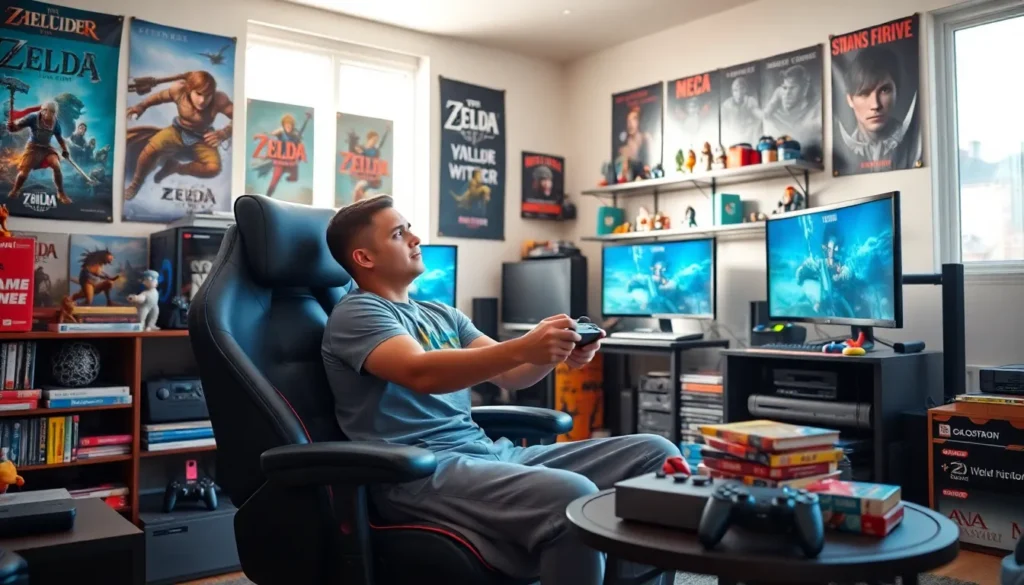Table of Contents
ToggleIn an age where video games have transcended beyond mere entertainment to become significant cultural phenomena, “Ramblings Of A Gamer” stands out as a treasure trove for gaming enthusiasts. This blog serves not only as a diary of gaming experiences but also as a comprehensive guide to understanding the multifaceted gaming landscape. This article explores various aspects of gaming, from its history and current trends to the vibrant community that surrounds it, offering a complete look at what it means to be a gamer in today’s world.
Understanding The Gaming Landscape

The Evolution of Gaming: A Brief History
The journey of gaming began in the 1950s and 1960s with simple text-based games and gradually evolved with the advent of home consoles in the 1970s and 1980s. The introduction of iconic systems such as the Atari and Nintendo Entertainment System laid the foundation for the gaming industry we know today.
Throughout the 1990s, we witnessed technological advancements that revolutionized gaming graphics, sound, and interactivity. The transition to 3D games and online multiplayer capabilities opened new horizons for gamers. The new millennium has brought about consistent innovation, including virtual reality (VR) and mobile gaming, making gaming accessible to a broader audience.
Current Trends in the Gaming Industry
Today, the gaming industry is thriving and continues to evolve at a rapid pace. Key trends include the rise of mobile gaming, where smartphones have become primary gaming devices for millions. Also, streaming services like Xbox Game Pass and PlayStation Now have made it easier to access a library of games without the need for physical copies. Meanwhile, the popularity of indie games has surged, with smaller studios creating innovative and captivating experiences, often pushing the boundaries of gameplay and storytelling.
Analyzing Game Genres and Their Impact
Role-Playing Games: Escaping Reality
Role-playing games (RPGs) have carved a niche in the hearts of gamers by providing immersive worlds that allow players to escape reality. Games like “The Witcher” and “Final Fantasy” series provide players with rich narratives and character development, encouraging creativity and problem-solving. These games often foster a sense of belonging and community, inviting players to share their experiences and strategies.
First-Person Shooters: The Action-Packed Experience
First-person shooters (FPS) like “Call of Duty” and “Counter-Strike” offer adrenaline-fueled action and have significantly influenced gaming culture. Their fast-paced nature promotes teamwork and communication, especially in multiplayer settings. Also, these games often serve as platforms for players to showcase their skills competitively, further enhancing their popularity.
Adventure Games: Immersive Storytelling
Adventure games such as “Zelda” and “Life is Strange” focus on storytelling, often allowing players to make choices that impact the narrative. These games emphasize exploration and puzzle-solving, engaging players in a way that often evokes emotional responses and deep participation in the game’s universe.
The Community and Culture of Gaming
The Rise of Online Multiplayer Communities
Online multiplayer communities have transformed how gamers interact. Platforms like Discord and Twitch enable players to connect, share experiences, and collaborate, fostering a sense of camaraderie. These communities have created an environment where players can engage in passionate discussions, share strategies, and develop lasting friendships based on shared interests.
Esports: Competitive Gaming’s New Era
Esports has emerged as a prominent force within the gaming world, turning casual games into professional competitions with substantial prize pools. Games like “League of Legends” and “Dota 2” have transformed into major spectator events, drawing millions to watch live matches. The rise of professional teams and individual players has further solidified the cultural significance of gaming, showcasing the immense skill and strategy involved in competitive play.
Creating Your Own Gaming Content
Starting a Gaming Blog: Tips and Tricks
For those passionate about sharing their gaming experiences, starting a gaming blog can be a rewarding venture. It’s essential to find a niche that resonates with your interests and audience. Tips include posting regularly, utilizing social media to promote content, and engaging with readers through comments and discussions. Authenticity and genuine enthusiasm for gaming can transform a simple blog into an impactful platform.
Engaging With Your Audience: Building a Community
Building a community around a gaming blog involves consistent interaction with the audience. This can be achieved by creating polls, responding to comments, and encouraging discussions on various gaming topics. Hosting giveaways or contests related to gaming can also spur engagement and promote a loyal follower base.
Exploring Reviews and Game Critiques
Writing Honest Game Reviews
Writing honest game reviews is crucial for building credibility as a gaming blogger. Reviews should focus on various aspects, such as gameplay, graphics, story, and sound. Providing constructive criticism while highlighting strengths ensures that readers trust your insights and recommendations.
Understanding Game Criticism: What Matters?
Game criticism involves analyzing various elements that contribute to a game’s success or failure. Key factors include gameplay mechanics, narrative structure, and player engagement. Understanding these elements can help gamers appreciate the art of game design and potentially enhance their own playing experiences.
Conclusion
“Ramblings Of A Gamer” is more than just a blog: it’s a celebration of the gaming community and culture. Understanding the gaming landscape, analyzing different genres, and engaging with an audience can lead to a richer gaming experience. Whether through creating content or immersing oneself in multiplayer communities, the journey as a gamer is constantly evolving.




